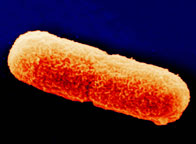| Research
|
|
|||||||||||||||||||||
|
Extreme microbe study under way DOE's
Joint Genome Institute (JGI) and the Diversa Corporation have
announced a collaboration in which they will identify and sequence
the genomes of microbes that can thrive under extreme conditions of
heat, cold, pressure and radiation. Diversa will use its proprietary
technologies to extract DNA from environmental samples and create
gene libraries, while JGI will perform the DNA sequencing. All DNA
sequence data from the collaboration will be provided to Diversa and
deposited in GenBank within six months of the completion of sequencing
to allow public access by scientists around the world.
The microbial world is the next genomic frontier," said JGI Director Eddy Rubin in announcing the collaboration. "We believe the scientific, environmental and commercial benefits from this project will be considerable and we're pleased to be working with Diversa." Said Jay M. Short, president and CEO of Diversa, a leader in developing novel commercial products from genes and gene pathways, "There are more genes in a handful of soil than in the entire human genome. We believe that our collaboration with JGI will contribute greatly to our understanding and utilization of microbial genes." Microbes are the oldest form of life on Earth and inhabit a wide range of environments including those hostile to most other life forms. By studying microbial DNA, scientists hope to find ways to use this rich genomic resource to develop new pharmaceutical and agricultural products, energy sources, industrial processes, and solutions to a variety of environmental problems. JGI and Diversa plan to sequence DNA from microbes living in deep-sea thermal vents, insect endosymbionts, soil from nuclear weapons manufacturing sites, and water collected by rainforest epiphytes. JGI is a collaboration between three DOE national laboratories: Lawrence Berkeley, Lawrence Livermore and Los Alamos. Funding comes predominantly from the Office of Biological and Environmental Research in DOE's Office of Science. Submitted by DOE's Berkeley Lab |



